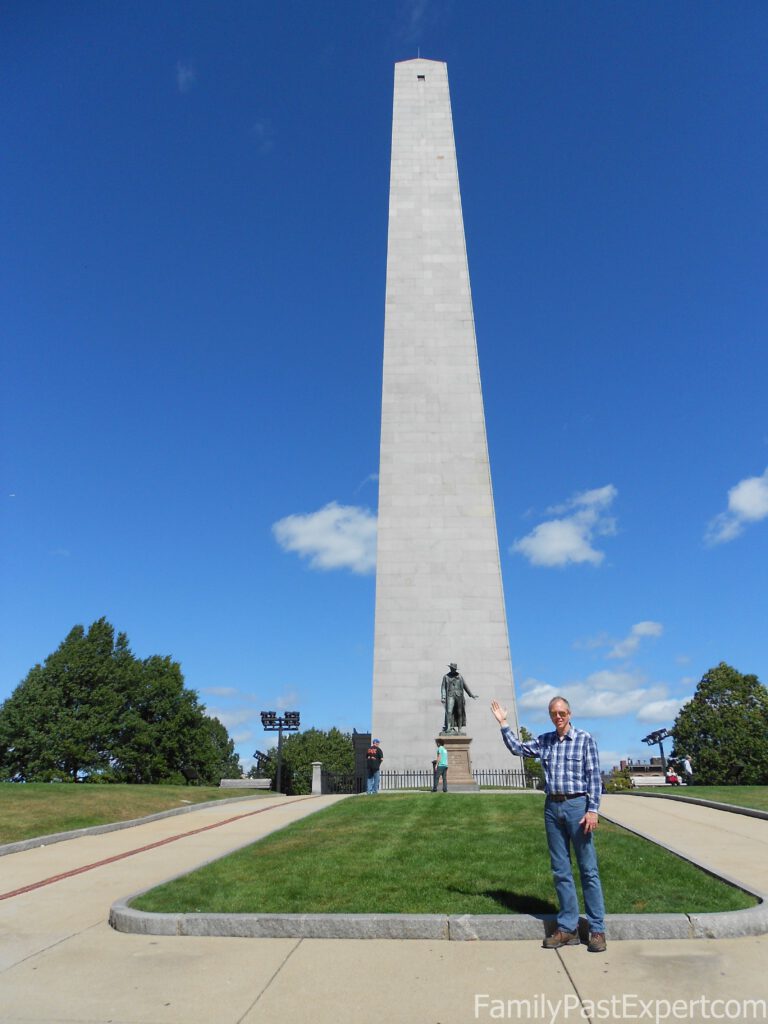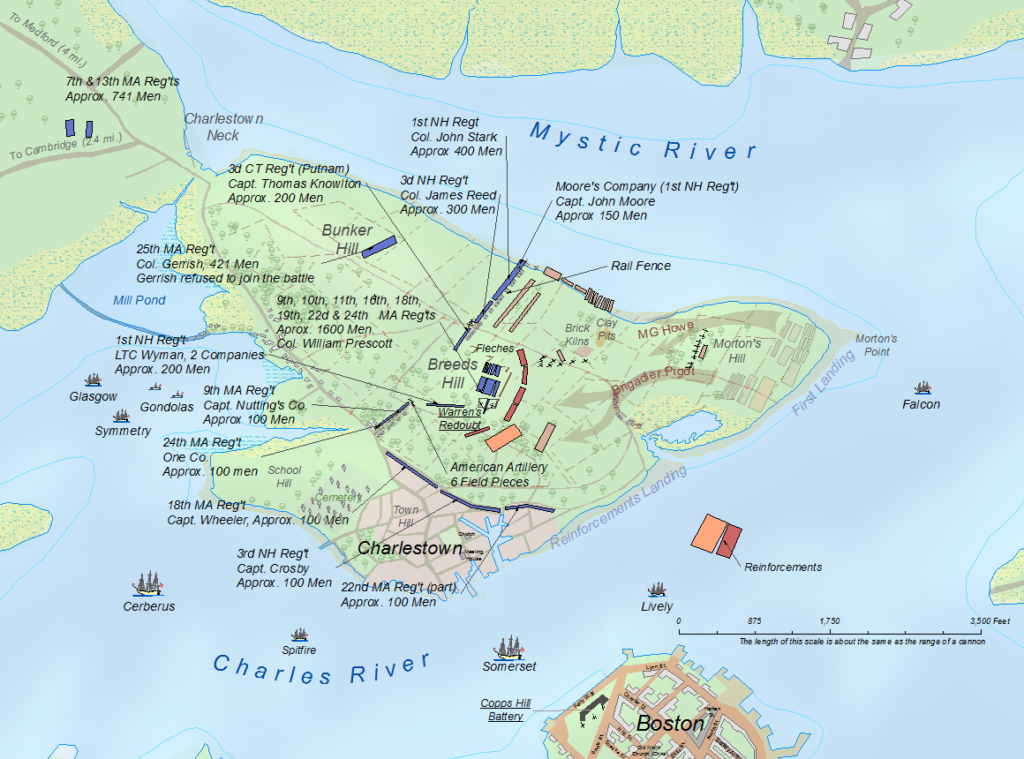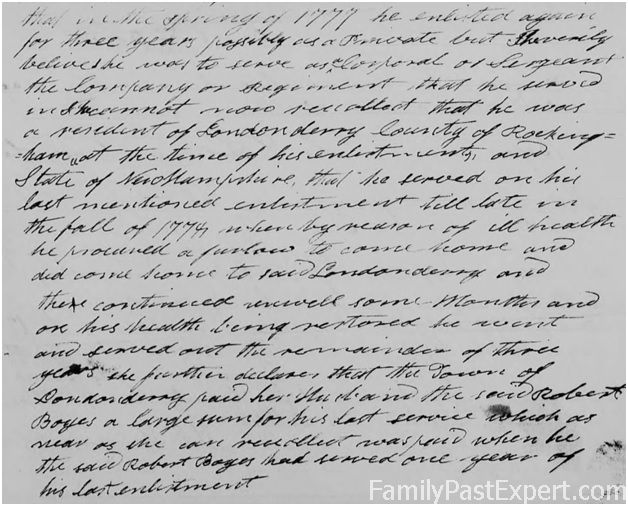Robert Boyes (1743-1803)
Happy 273rd Birth Anniversary to Revolutionary War soldier, Robert Boyes.
Robert Boyes was born on 24 Jun 1743 in Londonderry, Rockingham, New Hampshire.
We may be most familiar with Boyce as the way to spell this surname in the family tree, but Robert’s most common spelling in the records seems to have been Boyes. At times, the name has also been spelled Boice, Boys and Boyss.
Bunker Hill

A week before his 32nd birthday, Robert fought at Bunker Hill. Yes, the famous battle of Bunker Hill!
Robert was a Corporal in Captain Reid’s Company and Colonel Stark’s Regiment stationed near Boston. Robert and the New Hampshire Troops had been stationed near Boston. These troops were not very equipped and were not really battle-ready. Their opponent, however was the formally trained and well supplied British army.
About 6 p.m. on 16 June 1775, American troops from Massachusetts and Connecticut marched from Cambridge to occupy Breeds Hill. The hill overlooked Boston Harbor. They had been ordered to Bunker Hill, but Breeds Hill seemed to give them a better position for fighting, so they set up fortifications there. They worked until dawn constructing a redan which is an arrow-shaped embankment forming part of a fortification. They only got a little rest when a British ship opened fire on them from the harbor. When the light of morning came, Col. William Prescott, who was leading those American troops, could see that their flanks were unprotected, so he put his tired and hungry soldiers back to work.
Behind Prescott’s troops and fortification, there was a 600-foot rail fence that sloped toward the Mystic River. It was defended by Captain Knowlton and 200 Connecticut militia men who used hay to try to cover the fence. Six pieces of artillery had been placed in the empty space between the redan and the fence. But, they didn’t have proper ammunition.
Prescott sent for food and reinforcements! New Hampshire men were summoned to Bunker Hill. So, on 17 June 1775,when the Battle of Bunker Hill occurred, Robert Boyes was there. Robert and the other New Hampshire soldiers were ordered to take up on of two fences that ran parallel to the river and to stuff hay between the rails. They also built a low, short stone wall between the end of the rail fence and the edge of the Mystic River.
From their side of the river, the British decided to mount a traditional frontal assault. They assumed that the rebel troops consisted of “scoundrels” and “cowards” who would run away after the first bayonet charge. Because they had to cross water, it took a long time between their decision on how to attack and the attack itself.
From the heights of Bunker Hill, the Americans could watch the orderly movements of the British. They watched as British troops were allowed to stop for a lunch break while they themselves were hungry, dirty, tired, and very anxious about their first upcoming battle experience.
The British shot cannon balls and Charlestown was on fire. Then cannon fire stopped and the British soldiers marched forward in disciplined ranks. When the enemy was less than fifty feet away, the Americans were given the order to fire. As each line of British soldiers marched forward, they were shot down by American musket fire.

Eventually the British changed course and decided to attack a space between the redan and the fence, using reinforcements who had arrived from Boston. The Americans tried to fight back by firing nails and throwing rocks, because they had already used up their supplies of powder and shot. Robert Boyes was one of these Americans. The Americans were eventually forced to retreat.
The British officially won the battle, but they lost 1,054 of the 2,300 soldiers who had been sent to fight it. The Americans sustained a loss of about 450. But most importantly, the British lost a lot of their confidence. Until Bunker Hill, they had not acknowledged that the Americans were a force to be reckoned with.
After the battle, Robert continued to serve out his eight month enlistment.
Marriage
When he was 32, Robert married Genet Boyes, daughter of James Boyes, in the summer of 1776 in Litchfield, Hillsborough, New Hampshire. Yes, the bride and groom both had the same surname. It’s not known if they were at all related, but it is probably likely.
Re-enlistment
In the spring of 1777, Robert enlisted again for the term of three years. Robert received a £30 bounty for this service.

Children
Robert Boyes and Genet Boyes had the following children:
- Mary Boyce was born on 09 Jul 1777 in New Hampshire, USA. She died on 03 Apr 1853 in Enfield, Grafton, New Hampshire.
- Joseph Boyce was born on 11 Jan 1780 in New Hampshire, USA. He died on 13 Dec 1780 in New Hampshire.
- Hugh Boyce was born on 03 May 1783 in New Hampshire, USA. He died before 1845.
- Margaret Boyce was born on 30 Mar 1785 in New Hampshire, USA. She died on 12 Oct 1808 in Springfield, Sullivan, New Hampshire.
- Adam Boyce was born on 25 Jul 1787 in Londonderry, Rockingham, New Hampshire, USA. He married Mary Loverin on 02 Mar 1819 in Croydon, Sullivan, New Hampshire (then Cheshire county). He died on 17 Jun 1874 in Blackberry, Kane, Illinois.
- James Boyes was born on 29 Mar 1790 in Londonderry, Rockingham, New Hampshire. He married Martha Pillsbury on 14 Nov 1816 in New Hampshire. He died on 14 Mar 1868 in Springfield, Sullivan, New Hampshire, USA (Age: 77).
- Robert Boyce was born on 29 Jul 1799 in New Hampshire. He died on 17 Apr 1882 in Sullivan, New Hampshire (Age: 82).
Residences
Robert Boyes moved around New Hampshire in his later years. The following is a list of locations where he was recorded.
- 1775: Londonderry, Rockingham, New Hampshire.
- 1776: Londonderry, Rockingham, New Hampshire.
- 1790: Londonderry, Rockingham, New Hampshire.
- 1793: Manchester, Hillsborough, New Hampshire.
- 1794: Hopkinton, Merrimack, New Hampshire.
- 1798: Dunbarton, Merimack, New Hampshire
- 1799: Wendell, Cheshire, New Hampshire.
- 1800: Wendell, Cheshire, New Hampshire.
- 1803: Springfield, Sullivan, New Hampshire.
Death
Robert Boyes died on 27 Jul 1803 in Springfield, Sullivan, New Hampshire. He was sixty years old.
Pension
After his death, Robert’s family fought for decades to get the Revolutionary War pension for which they were entitled. Throughout the 170+ page pension file, we know that everything imaginable was challenged. His widow, Genet, had to prove that they’d actually been married. They had to fight to prove that Robert had actually served his second tour of duty. And, at one point, someone actually said they thought Robert had been a deserter. That was proven false, but caused delays in the processing of pension payments and no doubt caused the family a lot of stress. Genet Boyes did receive small pension payments of $27.44 per year, but in 1845, at the time of her death at age 91, she still hadn’t received all to which she was entitled. Some 42 years after Robert’s death, his children took over the fight. The case was finally closed in 1855, 52 years after Robert’s death. The full pension was never paid.

Where is he in the tree?
Update
In 2019, a member of our family, a fourth-great-granddaughter of Robert Boyes, obtained Daughters of the American Revolution membership through his service. His surname there is spelled Boyce and he is listed as Ancestor #: A213777. https://services.dar.org/public/dar_research/search_adb/?action=full&p_id=A213777.
Source:
1790 United States Federal Census, Year: 1790; Census Place: Londonderry, Rockingham, New Hampshire; Series: M637; Roll: 5; Page: 49; Image: 263; Family History Library Film: 0568145.
1800 United States Federal Census, Year: 1800; Census Place: Walpole, Cheshire, New Hampshire; Series: M32; Roll: 20; Page: 1050; Image: 176; Family History Library Film: 218679.
Ancestry.com, Revolutionary War Pension and Bounty-Land Warrant Application Files, 1800-1900 (Provo, UT, USA, Ancestry.com Operations, Inc., 2010), www.ancestry.com, Record for Robert Boyes.
“New Hampshire at Bunker Hill,” Revolutionary New Hampshire, Web, 20 June 2016, http://www.seacoastnh.com/history/rev/bunker.html.
Revolutionary War Pensions at Fold3, www.fold3.com, Robert Boyce, http://www.fold3.com.
The history of Londonderry : comprising the towns of Derry and Londonderry, N.H., Edward L. Parker (1851), p. 401 of 423; database on-line, Ancestry.com.



Leave a Reply